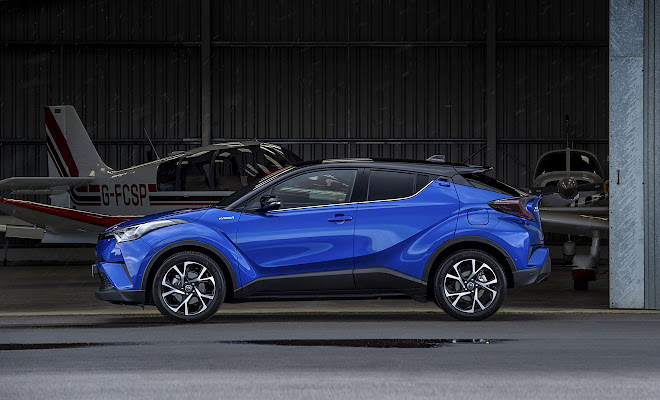Toyota’s latest hybrid car couldn’t be further from the prudent Prius in spirit. A jacked up, crossover five-door that seems to be straining in three different directions at once, the exuberant C-HR appears as a rather unlikely eco car.
However, with CO2 emissions as low as 86g/km and official combined cycle fuel economy of up to 74.3mpg, the C-HR should prove fairly frugal. The much less aggressively styled Kia Niro hybrid crossover is rated slightly worse at 88g/km, for example.
Unlike the Niro, the C-HR will also be offered with a non-hybrid engine. The 1.2-litre turbo petrol C-HR comes with CO2 emissions from 125g/km and an economy rating of 51.4mpg.

C-HR stands for Coupe High-Rider, by the way, which seems like a fairly good summary of its proposition. Sized to compete with the Nissan Qashqai, the C-HR’s arresting style is closer to that of the smaller Juke. Scratch that, it makes the Juke look positively timid.
The C-HR’s flamboyant looks may not be to everyone’s taste but you could never accuse it of being boring. I suspect it will attract quite a bit of interest. Toyota dealers are already gearing up for the new car’s arrival and many – like the Shelbourne Motors group in Northern Ireland – are busy taking test-drive bookings.
Toyota’s stylists have been let loose with their crayons of late, after decades of reserved, middle-of-the-road designs, and it’s clear they have a lot of pent-up energy to unleash. The C-HR’s surfaces are as busy as the M25 and as angular as a Dairylea triangle.

Some of the details jar a little – the prominent crease that swoops in five different directions over the flanks includes a tight little corner that pokes only a short way past the rear door’s cutline, for example. The small stranded triangle left behind on the C-pillar seems uncomfortably suggestive of a severed fingertip. Or maybe that’s just me.
The rear end is a jumbled selection of surfaces, spoilers and boomerang lamps, while the front end looks as fierce as Iron Man’s mask.
The hidden rear door-handle and truncated side glazing contribute to the car’s coupe vibe. I had a good prod at the C-HR at the recent Paris Motor Show and the rear door is quite unusual – you don’t often see a horizontal handle quite so high off the ground. Small children may not be able to reach.

Inside, the small side window can make the rear bench feel a little dark and claustrophobic. Over-the-shoulder vision from the driver’s seat is not going to be class-leading either.
But sit up front and the cabin feels like one of Toyota’s best efforts to date, with pleasing materials arranged in interesting shapes. A prominent touchscreen takes pride of place in the centre of the dash, jutting up to be close to the driver’s eyeline while still being neatly integrated. The relatively low upper surface of the rest of the dashboard creates a feeling of space.

Toyota UK has yet to officially confirm details of the powertrain, but a Japanese-market spec sheet and bit of fiddling with Google translate suggests that the C-HR’s hybrid system will have been lifted directly from the current fourth-generation Prius.
This arrangement uses a highly efficient 1.8-litre Atkinson-cycle petrol engine that produces up to 97bhp and 142Nm of torque. It is aided by a 53kW (71bhp) electric motor yielding another 163Nm of torque. Overall system output peaks at 121bhp (90kW). Hybrid energy storage is handled by a modest 1.31kWh nickel-metal hydride battery.
The C-HR doesn’t plug in – at least for now. Given that a new and promising Prius Plug-in is on the way, it’s not inconceivable that a mains-charged powertrain might find its way into the body of the C-HR. We will have to wait and see.

Acceleration times and the C-HR’s weight in European trim have yet to be confirmed, though the Japanese version comes in at 1,440kg – not a great deal heavier than the Prius, which weighs 1,400kg in its top spec. With bigger wheels and what looks like a much less slippery shape, the C-HR is unlikely to match the Prius for real-world economy, of course.
Pre-option prices for the hybrid version of the C-HR start at £23,595 for the entry-level Icon trim level, £26,495 for the mid-range Excel and £27,995 for the top Dynamic edition. Very similar in price, in fact, to the Prius on which it’s based.





